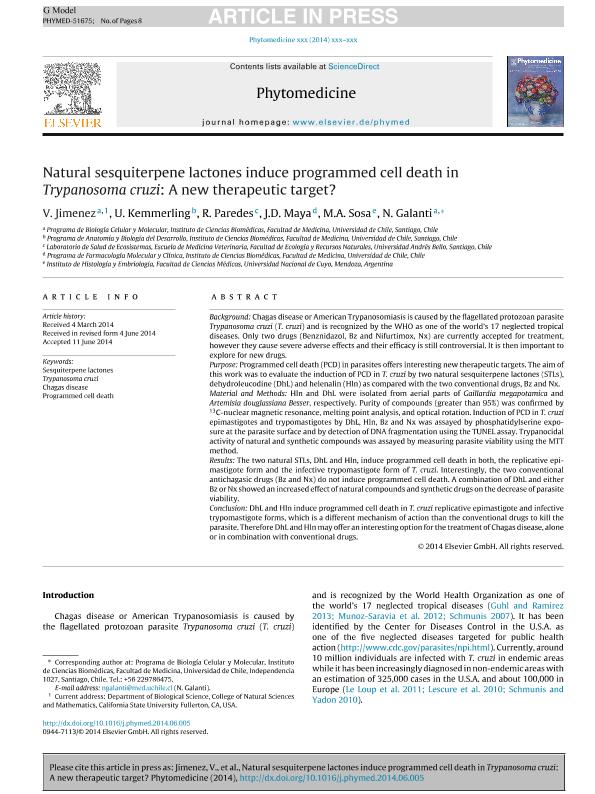Mostrar el registro sencillo del ítem
dc.contributor.author
Jimenez, V.
dc.contributor.author
Kemmerling, U.
dc.contributor.author
Paredes, Rogelio Claudio

dc.contributor.author
Maya, J. D.
dc.contributor.author
Sosa Escudero, Miguel Angel

dc.contributor.author
Galanti, N.
dc.date.available
2018-01-02T19:35:40Z
dc.date.issued
2014-07
dc.identifier.citation
Galanti, N.; Sosa Escudero, Miguel Angel; Maya, J. D.; Paredes, Rogelio Claudio; Kemmerling, U.; Jimenez, V.; et al.; Natural sesquiterpene lactones induce programmed cell death in Trypanosoma cruzi: a new therapeutic target?; Elsevier Gmbh; Phytomedicine; 21; 11; 7-2014; 1411-1418
dc.identifier.issn
0944-7113
dc.identifier.uri
http://hdl.handle.net/11336/32036
dc.description.abstract
BACKGROUND: Chagas disease or American Trypanosomiasis is caused by the flagellated protozoan parasite Trypanosoma cruzi (T. cruzi) and is recognized by the WHO as one of the world's 17 neglected tropical diseases. Only two drugs (Benznidazol, Bz and Nifurtimox, Nx) are currently accepted for treatment, however they cause severe adverse effects and their efficacy is still controversial. It is then important to explore for new drugs.
PURPOSE: Programmed cell death (PCD) in parasites offers interesting new therapeutic targets. The aim of this work was to evaluate the induction of PCD in T. cruzi by two natural sesquiterpene lactones (STLs), dehydroleucodine (DhL) and helenalin (Hln) as compared with the two conventional drugs, Bz and Nx.
MATERIAL AND METHODS: Hln and DhL were isolated from aerial parts of Gaillardia megapotamica and Artemisia douglassiana Besser, respectively. Purity of compounds (greater than 95%) was confirmed by (13)C-nuclear magnetic resonance, melting point analysis, and optical rotation. Induction of PCD in T. cruzi epimastigotes and trypomastigotes by DhL, Hln, Bz and Nx was assayed by phosphatidylserine exposure at the parasite surface and by detection of DNA fragmentation using the TUNEL assay. Trypanocidal activity of natural and synthetic compounds was assayed by measuring parasite viability using the MTT method.
RESULTS: The two natural STLs, DhL and Hln, induce programmed cell death in both, the replicative epimastigote form and the infective trypomastigote form of T. cruzi. Interestingly, the two conventional antichagasic drugs (Bz and Nx) do not induce programmed cell death. A combination of DhL and either Bz or Nx showed an increased effect of natural compounds and synthetic drugs on the decrease of parasite viability.
CONCLUSION: DhL and Hln induce programmed cell death in T. cruzi replicative epimastigote and infective trypomastigote forms, which is a different mechanism of action than the conventional drugs to kill the parasite. Therefore DhL and Hln may offer an interesting option for the treatment of Chagas disease, alone or in combination with conventional drugs.
dc.format
application/pdf
dc.language.iso
eng
dc.publisher
Elsevier Gmbh

dc.rights
info:eu-repo/semantics/openAccess
dc.rights.uri
https://creativecommons.org/licenses/by-nc-nd/2.5/ar/
dc.subject
Sesquiterpene Lactones
dc.subject
Trypanosoma Cruzi
dc.subject
Chagas Disease
dc.subject
Programmed Cell Death
dc.subject.classification
Otras Ciencias Biológicas

dc.subject.classification
Ciencias Biológicas

dc.subject.classification
CIENCIAS NATURALES Y EXACTAS

dc.title
Natural sesquiterpene lactones induce programmed cell death in Trypanosoma cruzi: a new therapeutic target?
dc.type
info:eu-repo/semantics/article
dc.type
info:ar-repo/semantics/artículo
dc.type
info:eu-repo/semantics/publishedVersion
dc.date.updated
2017-12-29T14:10:41Z
dc.journal.volume
21
dc.journal.number
11
dc.journal.pagination
1411-1418
dc.journal.pais
Alemania

dc.description.fil
Fil: Jimenez, V.. Universidad de Chile; Chile
dc.description.fil
Fil: Kemmerling, U.. Universidad de Chile; Chile
dc.description.fil
Fil: Paredes, Rogelio Claudio. Universidad Andrés Bello; Chile. Consejo Nacional de Investigaciones Científicas y Técnicas. Centro Científico Tecnológico Conicet - Mendoza; Argentina
dc.description.fil
Fil: Maya, J. D.. Universidad de Chile; Chile
dc.description.fil
Fil: Sosa Escudero, Miguel Angel. Consejo Nacional de Investigaciones Científicas y Técnicas. Centro Científico Tecnológico Conicet - Mendoza. Instituto de Histología y Embriología de Mendoza Dr. Mario H. Burgos. Universidad Nacional de Cuyo. Facultad de Cienicas Médicas. Instituto de Histología y Embriología de Mendoza Dr. Mario H. Burgos; Argentina
dc.description.fil
Fil: Galanti, N.. Universidad de Chile; Chile
dc.journal.title
Phytomedicine

dc.relation.alternativeid
info:eu-repo/semantics/altIdentifier/url/http://www.sciencedirect.com/science/article/pii/S0944711314002542
dc.relation.alternativeid
info:eu-repo/semantics/altIdentifier/doi/http://dx.doi.org/10.1016/j.phymed.2014.06.005
Archivos asociados
